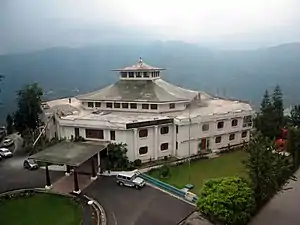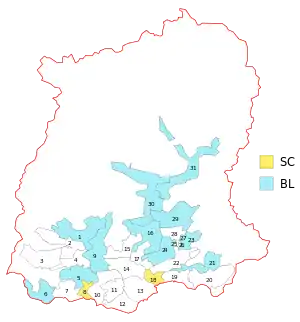Sikkim Legislative Assembly | |
|---|---|
| 10th Sikkim Assembly | |
 | |
| Type | |
| Type | |
Term limits | 5 years |
| Seats | 32 |
| Elections | |
| First past the post | |
Last election | 11 April 2019 |
| Meeting place | |
 | |
| Sikkim Legislative Assembly, Gangtok, Sikkim, India | |
| Website | |
| Sikkim Legislative Assembly | |
The Sikkim Legislative Assembly is the unicameral legislature of the state of Sikkim, in Northeast India. The seat of the Legislative Assembly is at Gangtok, the capital of the state. The assembly sits for a term of five years, unless it is dissolved earlier. Sikkim is the second-smallest state in India, covering 7,096 km2 (2,740 sq mi); and the seventh-least populous state with a population of 6.10 lakhs. The Sikkim Legislative Assembly has existed since 1975. As of the 2019 elections, it has 32 constituencies, whom are democratically elected using the First-past-the-post system.
Since the independence of India, the Scheduled Castes (SC) and Scheduled Tribes (ST) have been given Reservation status, guaranteeing political representation, and the Constitution lays down the general principles of positive discrimination for SCs and STs. The Scheduled Tribes have been granted a reservation of 12 seats in the assembly, while 2 constituencies are reserved for candidates of the Scheduled Castes. 1 constituency (Sangha) is reserved for registered Buddhist monks and nuns from the state's monasteries. 2 constituencies (West Pendam and Salghari–Zoom) are reserved for people of the Scheduled Castes (SC). 12 constituencies are reserved for people of the Bhutia-Lepcha (BL) community.
History
| Year | Details | Constituencies | Seats | Elections | ||||
|---|---|---|---|---|---|---|---|---|
| Nepali | BL | Others | Appointed | Total | ||||
| 1952 | Elections announced for a new State Council with 12 (out of 18) elected members | 4 | 6 | 6 | 0 | 6 | 18 | 1953 |
| 1958 | Seats increased to 20[1] | 4 | 6 | 6 | 2 (Sangha, General) | 6 | 20 | 1958 |
| 1966 | Representation of Sikkim Subjects Regulation, 1966[2] Constituencies increased to 5, 2 additional general seats added |
5 | 7 | 7 | 4 (Sangha, Tsong, SC, General) |
6 | 24 | 1967, 1970 and 1973 |
| 1974 | The Government of Sikkim Act, 1974[3] Multi-seat constituencies eliminated |
32 | 15 | 15 | 2 (Sangha, SC) | 0 | 32 | 1974 |
Constituencies

The following is a list of the constituencies of the Sikkim Legislative Assembly[4]
Reservation
| No. | Name | Reserved for (SC/BL/None) |
District[5] | Lok Sabha constituency |
Electors (2019)[6] |
|---|---|---|---|---|---|
| 1 | Yoksam–Tashiding | BL | Gyalshing | Sikkim | 13,808 |
| 2 | Yangthang | None | 12,952 | ||
| 3 | Maneybong–Dentam | 15,174 | |||
| 4 | Gyalshing–Barnyak | 12,406 | |||
| 5 | Rinchenpong | BL | Soreng[7] | 14,756 | |
| 6 | Daramdin | 15,269 | |||
| 7 | Soreng–Chakung | None | 15,589 | ||
| 8 | Salghari–Zoom | SC | 10,942 | ||
| 9 | Barfung | BL | Namchi | 14,875 | |
| 10 | Poklok–Kamrang | None | 15,595 | ||
| 11 | Namchi–Singhithang | 12,689 | |||
| 12 | Melli | 15,479 | |||
| 13 | Namthang–Rateypani | 15,451 | |||
| 14 | Temi–Namphing | 14,225 | |||
| 15 | Rangang–Yangang | 13,919 | |||
| 16 | Tumin–Lingee | BL | 15,888 | ||
| 17 | Khamdong–Singtam | None | Gangtok | 13,067 | |
| 18 | West Pendam | SC | Pakyong[8] | 14,984 | |
| 19 | Rhenock | None | 17,396 | ||
| 20 | Chujachen | 17,776 | |||
| 21 | Gnathang–Machong | BL | 12,048 | ||
| 22 | Namchaybong | None | 15,095 | ||
| 23 | Shyari | BL | Gangtok | 15,732 | |
| 24 | Martam–Rumtek | 16,975 | |||
| 25 | Upper Tadong | None | 10,334 | ||
| 26 | Arithang | 11,408 | |||
| 27 | Gangtok | BL | 11,649 | ||
| 28 | Upper Burtuk | None | 15,231 | ||
| 29 | Kabi–Lungchok | BL | Mangan | 12,661 | |
| 30 | Djongu | 9,595 | |||
| 31 | Lachen–Mangan | 7,867 | |||
| 32 | Sangha | Sangha[9] | Buddhist Monasteries | 3,293 |
See also
References
- ↑ Tashi Namgyal (16 March 1958). "Proclamation of His Highness Sir Tashi Namgyal, KCSI, KCIE, Maharaja of Sikkim, Dated the 16th March, 1958" (PDF). p. 102. Archived from the original (PDF) on 29 January 2023. Retrieved 16 June 2021.
- ↑ Palden Thondup Namgyal (21 December 1966). "Representation of Sikkim Subjects Regulation, 1966". pp. 117–119. Archived from the original on 27 June 2021. Retrieved 1 July 2021.
- ↑ "The Government of Sikkim Act, 1974". 6 July 1974. Archived from the original on 9 July 2021. Retrieved 1 July 2021.
- ↑ "List of constituencies". ceosikkim.nic.in. Retrieved 17 February 2023.
- ↑ "Sikkim gets two new districts, remaining four renamed". NORTHEAST NOW. 22 December 2021. Retrieved 17 February 2023.
- ↑ "Vidhan Sabha Elections Sikkim 2019 - Voters Turnout Statistical Data" (PDF). ceosikkim.nic.in. Retrieved 1 January 2021.
- ↑ "Soreng district status will cater to growing population, administrative needs of four constituencies: Aditya". Sikkimexpress. 22 June 2021. Retrieved 17 February 2023.
- ↑ Pankaj Dhungel (21 June 2021). "3 sub-divisions of East Sikkim to form Sikkim's newest district Pakyong". East Mojo. Retrieved 20 September 2021.
- ↑ Shiv Sahay Singh (4 April 2019). "32-Sangha constituency: Sikkim's intangible seat, where only monks contest and vote". The Hindu. Retrieved 3 January 2021.